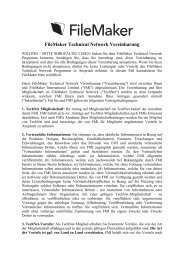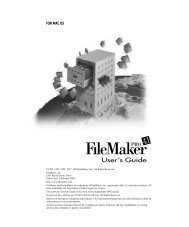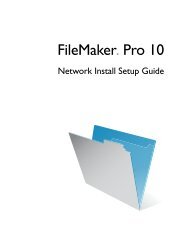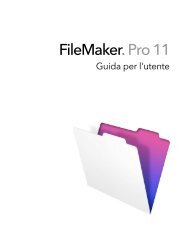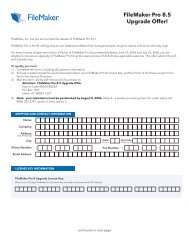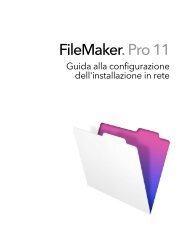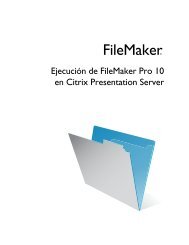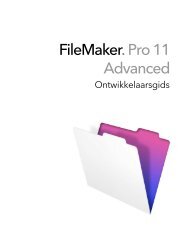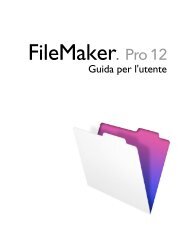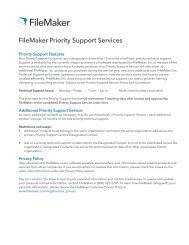Guida di FileMaker Server 12
Guida di FileMaker Server 12
Guida di FileMaker Server 12
You also want an ePaper? Increase the reach of your titles
YUMPU automatically turns print PDFs into web optimized ePapers that Google loves.
Configurazione delle impostazioni del server database Impostazioni del database<br />
Impostazioni del database<br />
Nota Le seguenti informazioni sono destinate ad amministratori server.<br />
<strong>Server</strong> database > scheda Database specifica le seguenti impostazioni <strong>di</strong> configurazione:<br />
• Specificare il numero massimo <strong>di</strong> file che <strong>FileMaker</strong> <strong>Server</strong> può ospitare.<br />
• Selezionare se <strong>FileMaker</strong> <strong>Server</strong> ospita automaticamente soluzioni runtime registrate.<br />
• Specificare la quantità <strong>di</strong> memoria per la cache del database.<br />
• Specificare la frequenza con cui viene scaricata la cache del database.<br />
Per specificare le impostazioni del database:<br />
1. Scegliere <strong>Server</strong> database > scheda Database.<br />
A Eseguire questa operazione<br />
Specificare il numero<br />
massimo <strong>di</strong> file <strong>di</strong><br />
database che <strong>FileMaker</strong><br />
<strong>Server</strong> può aprire<br />
contemporaneamente<br />
Hosting automatico <strong>di</strong><br />
file <strong>di</strong> soluzioni runtime<br />
Per Numero massimo <strong>di</strong> file da ospitare inserire un numero.<br />
Nota La memoria necessaria a <strong>FileMaker</strong> <strong>Server</strong> <strong>di</strong>pende dal<br />
numero <strong>di</strong> client collegati e <strong>di</strong> file aperti. Se si specificano gran<strong>di</strong><br />
valori, è necessario anche aumentare la quantità <strong>di</strong> RAM riservata<br />
alla cache dei database.<br />
In Soluzioni runtime registrate selezionare Permetti a <strong>FileMaker</strong><br />
<strong>Server</strong> <strong>di</strong> ospitare automaticamente le soluzioni runtime registrate.<br />
• Per registrare un tipo <strong>di</strong> file per una soluzione runtime, fare<br />
clic su Registra e <strong>di</strong>gitare l’estensione del nome del file.<br />
Fare clic su OK.<br />
• Per rimuovere un tipo <strong>di</strong> file registrato, selezionarlo nella<br />
lista Tipo <strong>di</strong> file e fare clic su Rimuovi. Fare clic su Sì<br />
per confermare.<br />
Se si ospitano soluzioni <strong>di</strong> database runtime create da<br />
<strong>FileMaker</strong> Pro Advanced, è possibile attivare per <strong>FileMaker</strong> <strong>Server</strong><br />
l’apertura automatica <strong>di</strong> soluzioni runtime all’avvio <strong>di</strong> <strong>FileMaker</strong><br />
<strong>Server</strong>. Le soluzioni runtime devono essere memorizzate in una<br />
delle posizioni in<strong>di</strong>cate. Vedere la sezione Impostazioni delle<br />
cartelle predefinite.<br />
Se le soluzioni runtime non hanno estensione .fp<strong>12</strong>, è necessario<br />
registrare tali estensioni in <strong>FileMaker</strong> <strong>Server</strong>.<br />
GUIDA DI FILEMAKER SERVER <strong>12</strong> 60



